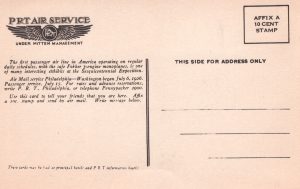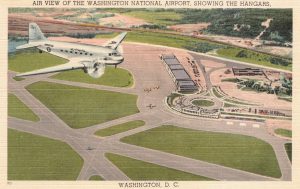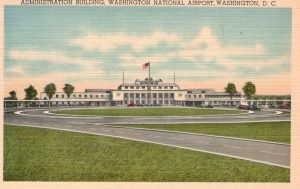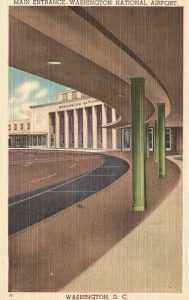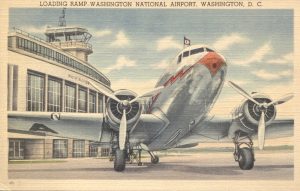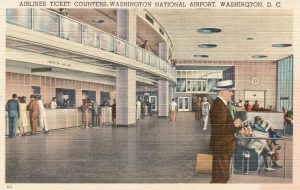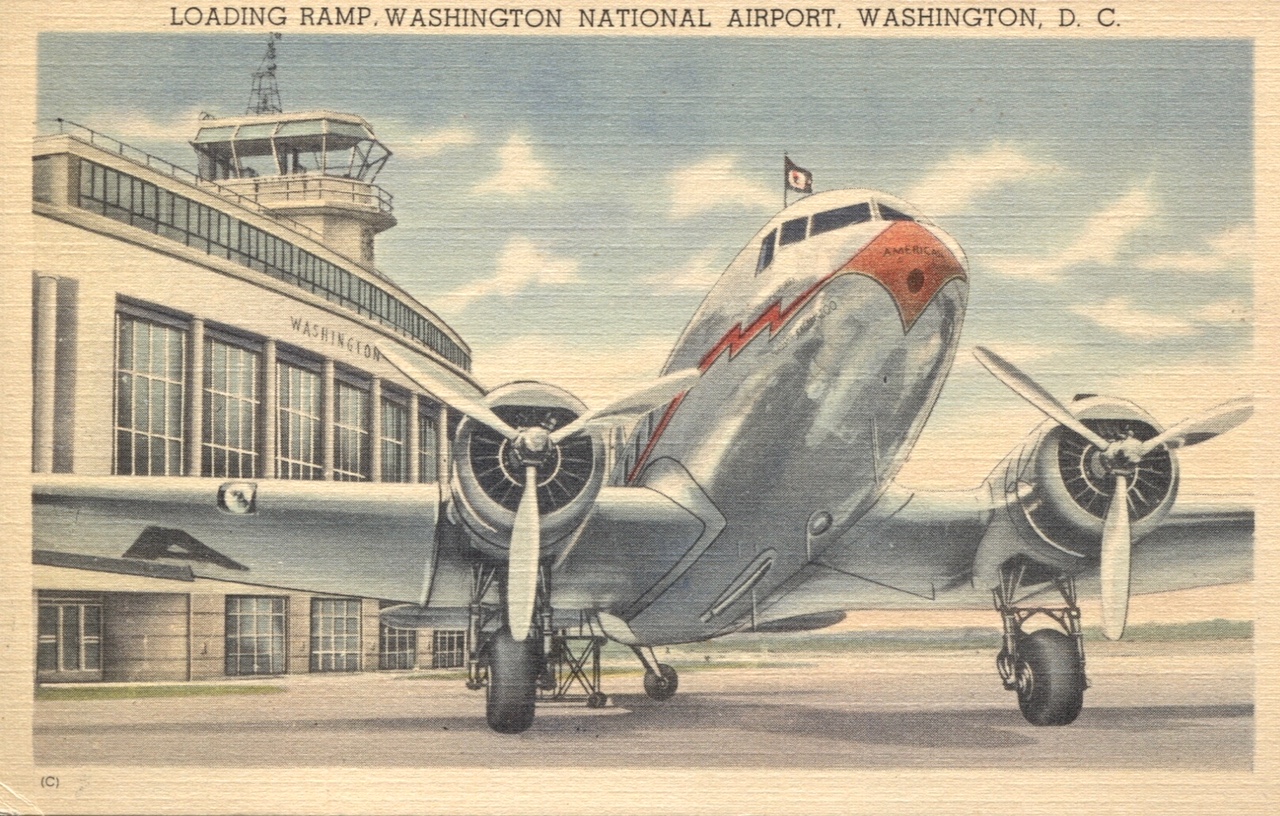
Washington National Airport in Postcards
Written by Marvin G. Goldman
Ronald Reagan Washington National Airport (code ‘DCA’) is the closest airport to Washington, D.C. (District of Columbia), the U.S. capital. Although located only four miles (7 km.) from the heart of the capital district, the airport actually lies just across the Potomac River near the Crystal City urban neighborhood of Arlington County, Virginia.
The first significant air field and terminal in the National Capital area was privately owned Hoover Field. Officially opened on 16 July 1926, it was located on the Virginia side of the Potomac River just north of the present DCA, on a site now occupied by the Pentagon. The first airline to operate there was Philadelphia Rapid Transit Air Service (‘PRT’) which started passenger and mail flights between Philadelphia and Hoover Field.
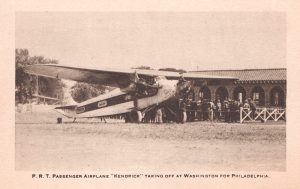
Philadelphia Rapid Transit Air Service (‘PRT’) Fokker F-VIIa-3m, ‘Kendrick’, at Hoover Field, Arlington County, Virginia, serving on the Washington-Philadelphia route, July-November 1926. Airline Issue.
The route from Hoover Field to Philadelphia proved uneconomical for the Philadelphia Rapid Transit airline. Also, the field itself was not well suited for airline operations. So PRT pulled out of Hoover Field after five months. Potomac Flying Service then started operating at Hoover Field, but with only mixed success.
Just one year later, In 1927, a competing private field called ‘Washington Airport’ opened adjacent to Hoover Field. However, faced with small sites that were often flooded, flight path obstacles, and financial difficulties, the two fields merged in September 1930 to form ‘Washington-Hoover Airport’. This did not sufficiently help the situation, as the combined site was still not worthy of serving as the principal airport for the Nation’s capital city.
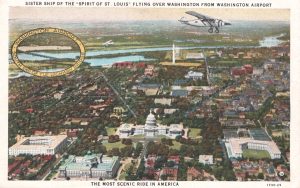
Postcard issued in late 1928 or early 1929 showing ‘Washington Airport’ (later part of ‘Washington-Hoover Airport’) within the upper left circle on the far side of the Potomac River. The card advertises scenic flights over Washington operated by a Ryan Brougham aircraft and was probably issued by the owner-operator of those flights, Herbert Fahy who was a co-founder of ‘Washington Airport’. There are three versions of this card: two have a “Safety 1928’ ‘United States Air Transport’ insignia on the back (with the front of one version being less colorized), and the back of the third has a message promoting the scenic flights.
Following the failure of Congress to agree on a new site for the development of a suitable airport for the national capital, in fall 1938 President Franklin D. Roosevelt selected a site for a totally new U.S. government-owned airport to be built just south of Washington-Hoover Airport on mudflats at Gravelly Point, by the Potomac River. Construction involved a tremendous amount of earth moving, reclaiming land from the marshes and river. The new airport, named ‘Washington National Airport’, opened for commercial flights on 16 June 1941. It was considered one of the finest of its day, with innovations in building design, plane handling, air and field traffic control, lighting, and facilities for public convenience. The first three airlines to operate there were American Airlines, Eastern Air Lines, and Pennsylvania Central Airlines (‘PCA’).
During the first few years of the new airport, a legal controversy existed as to whether the airport was in fact located in Virginia or was part of the federal District of Columbia. In 1945 Congress passed a law stating the airport site was indeed in Virginia, but that the airport was under exclusive federal jurisdiction.
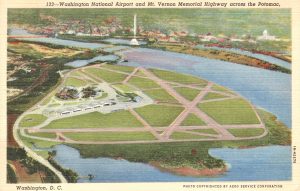
Aerial view of new Washington National Airport showing its four runways, Curteich no. 1B-H2275; 1941, the year of its inauguration. The deactivated Washington-Hoover Airport field can be seen at the empty land just northwest of the new airport.
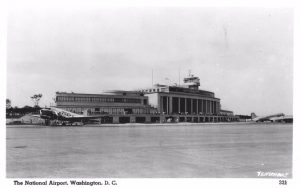
The terminal and administration building of Washington National Airport, early 1940s. Real photo postcard by Tenschert, no. 321. An American Airlines Douglas DC-3 is at left, and an Eastern Air Lines DC-3 at right.
After Washington National Airport opened, a nice set of 18 different colorized ‘linen’ finish postcards about the airport was published, likely between 1942 and 1945, by Capitol Souvenir Company (‘Capsco’) of Washington D.C., along with a souvenir folder of non-postcard photos of those 18 views. So-called ‘linen’ postcards derived their name from the surface pattern of the card that resembled the crosshatched surface of linen fabric. They were popular mainly from 1930 to 1945, at which time postcards with a ‘chrome’ finish and more realistic photos became the dominant form of postcard.
Here are nine of those Capsco ‘linen’ postcards selected from the set.
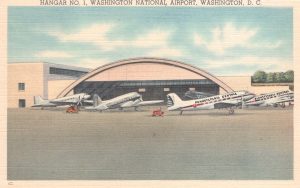
The first hangar built at Washington National Airport. In front are Douglas DC-3s of the first three airlines serving the airport — American, Eastern and Pennsylvania Central.
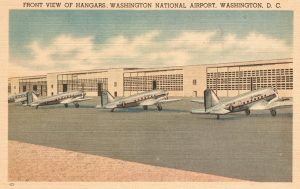
American DC-3s in front of the row of more modern hangars built at Washington National Airport soon after its opening.
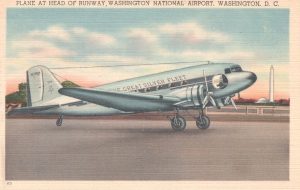
Eastern Air Lines DC-3, with Jefferson Memorial and Washington Monument seen across the Potomac River.
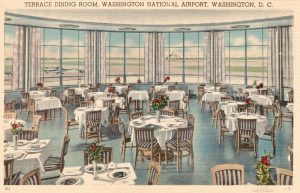
From the dining room and through the panoramic glass of the terminal waiting room, passengers could look out towards the aircraft activity and also see, as here, the Washington Monument and U.S. Capitol building on the other side of the Potomac River.
Several ‘chrome’ finish postcards depict the original Washington National Airport (which had added in 1950 an extension to the main terminal at its south end). Here is a selection of five postcards that show aircraft on the ramp with the administration/terminal building in the background.
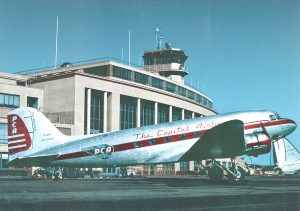
Pennsylvania Central Airlines (‘PCA’) Douglas DC-3, NC49553, at Washington National Airport between 1945 and 1948, issued for Airliners International 2006 Washington. Pub’r j.j.postcards, Bassersdorf, Switzerland. This aircraft joined PCA’s fleet in March 1945, and PCA changed its name to Capital Airlines in April 1948.
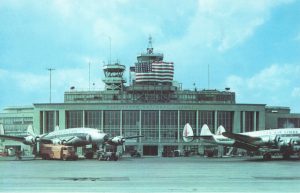
Eastern Air Lines Lockheed Constellations at Washington National Airport. Dexter Press no. 51413, Pub’r Racon Wholesale, Washington D.C. Eastern was a large operator of Constellations, with 79 of different types serving during the period 1945 to 1968. On 30 April 1961 Eastern inaugurated its iconic ‘Air-Shuttle’ service between Washington National and New York-LaGuardia and Boston-Logan, with L1049 Constellation aircraft.
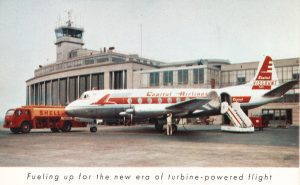
Capital Airlines Vickers Viscount turboprop at Washington Airport. Airline issue. In 1955 Capital became the first U.S. operator of the Viscount.
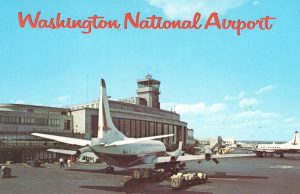
Eastern Air Lines Lockheed 188 Electra at Washington National Airport. Pub’r Capsco, Washington D.C., no. P61914. Eastern started adding Electra turboprops to its fleet in late 1958, and introduced them on its Air-Shuttle service in 1965. Also in 1958 the airport’s infrastructure expanded with the opening of its ‘North Terminal’.
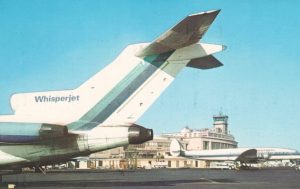
Eastern Air Lines Boeing 727 and Lockheed Constellation at Washington National Airport. Pub’r: Capsco, no. P72871. Eastern was the launch airline for the 727 and placed it in service on the Philadelphia-Washington-Miami route on 1 February 1964.
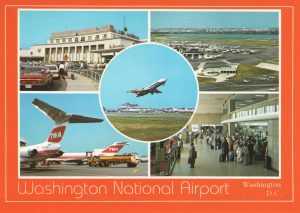
Washington National Airport (‘DCA’) 5-View Card. Printed by John Hinde Curteich, Distr. L. B. Prince, Fairfax VA, D. Noble Photos, probably issued in the 1970s or 1980s. In 1970 facilities for TWA and Northwest airlines opened at Washington National. Examples of their aircraft appear in the lower left and center views respectively in this postcard. Delta, Pan Am, United, US Air and other airlines also started serving DCA.
In 1987 U.S. federal control of Washington National Airport (along with Dulles, the more distant Washington airport that mainly serves longer-haul flights) was transferred to the Metropolitan Washington Airports Authority, an independent interstate agency created by legislation of the State of Virginia and the District of Columbia, with the consent of Congress.
On 12 May 1997 a new modern and taller airport traffic control tower at Washington National was commissioned by the Federal Aviation Administration, and on 27 July 1997 the airport was transformed by the official opening of an entirely new modern north terminal (called Terminals B and C), featuring three levels, 35 aircraft gates and a beautiful ‘National Hall’ concourse with numerous shops and restaurants.
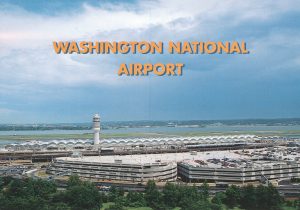
Aerial view of Washington National Airport and its new terminal, issued by the Metropolitan Washington Airports Authority, Alexandria VA. Oversize card, 12.4 x 17.7 cms.
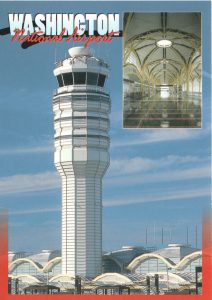
Control Tower and Interior at Washington National Airport. Distr. L. B. Prince Co., Fairfax VA, no. K25434, E. David Luna Photo.
On 6 February 1998 the airport name was changed from ‘Washington National’ to ‘Ronald Reagan Washington National Airport’, in honor of the 40th President of the U.S., who served from 1981 to 1989. The airport code ‘DCA’ remained the same.
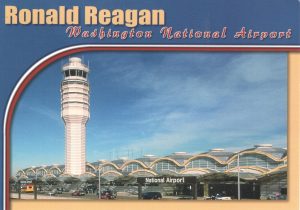
Front View of Ronald Reagan Washington National Airport, with Control Tower. Pub’r Shin Sung Souvenir Co., Washington D.C., no. 02642, E. David Luna Photo.
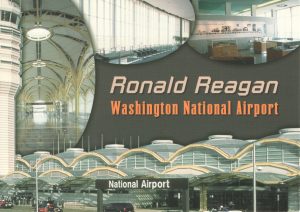
Four View Postcard of Ronald Reagan Washington National Airport. Pub’r Shin Sung Souvenir Co., Washington D.C., no. 02638, E. David Luna Photo.
The original terminal at National Airport is now known as ‘Historic Terminal A’. Not only does it still exist, it has been restored during a period of over ten years, with renovation being completed in 2014. It is now used by three airlines, and it also has an area for historical displays.
Today Reagan Washington National Airport is served by eight airlines: American and jetBlue (in Terminals B and C), Alaska, Delta and United (Terminal B), and Air Canada, Frontier and Southwest (Historic Terminal A). The airport mainly operates as a ‘short-haul’ airport, with flights to destinations no further than 1,250 miles from Washington D.C. per a federally-instituted ‘Perimeter Rule’; however, exceptions to this rule have been granted by the federal government allowing flights to several major cities beyond the perimeter. Also, the largest aircraft types do not operate out of Reagan National because, due to its limited land area, the airport runways are relatively short, the longest being 6,869 ft. (2,094m).
Lastly, Reagan National is also subject to the ‘slot rule’ created by the Federal Aviation Administration at certain high-density airports to reduce congestion; this limits the number of landings and takeoffs per hour. In 2014 American Airlines, in order to obtain government approval for its merger with US Airways, was forced to sell 104 takeoff and landing slots at Reagan National. Almost all of those slots were acquired by Southwest and jetBlue Airlines.
Despite the limitations on number and distance of flights and size of aircraft, Reagan Washington National Airport today is one of the busiest in the U.S. In 2019 it served nearly 24 million passengers. As documented by postcards, the closest airport to the heart of the nation’s capital has come a long way from the sod airstrip at Hoover Field to the modern facility at Reagan National.
Notes:
All postcards shown are in the author’s collection. I estimate their rarity as follows: Rare: the Philadelphia Rapid Transit Air Service card; Uncommon: the scenic flights over Washington card, first two Washington National Airport cards, all cards in the 1940s ‘linen’ set, the card with two Eastern Constellations, the Capital Viscount card, and the oversize aerial view of the new terminal. The rest of the postcards are fairly common.
Be sure to attend Airliners International DCA 2018, where the convention and show will be held virtually next door to Reagan Washington National Airport. See you there !
References:
Metropolitan Washington Airports Authority, Reagan National, website ‘flyreagan.com’. In the top search box, type ‘about the airport’ and in the list that appears click on the first item ‘About Reagan National Airport’.
Website: airfields-freeman.com, tab ‘Abandoned & Little-Known Airfields: Virginia: Arlington County’, by Paul Freeman (revised 18 Feb. 2018).
Website: http://famgus.se/Vykort/APC-WNA.html. This site shows all 18 of the early 1940’s Capsco ‘linen’ postcard set of Washington National Airport.
Szurvoy, Geza. ‘The American Airport’ (MBI Publishing Co., 2003).
Trackback from your site.

